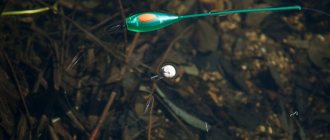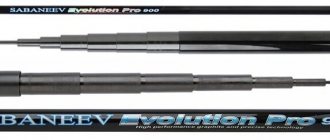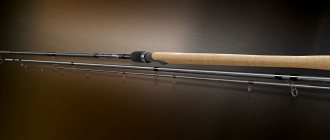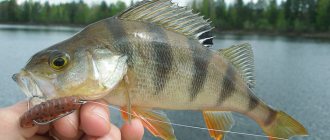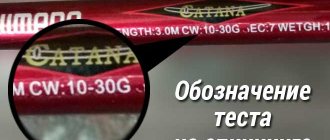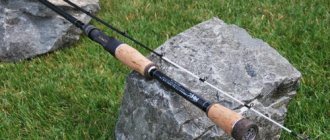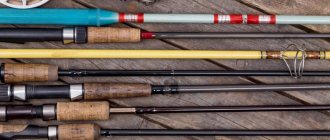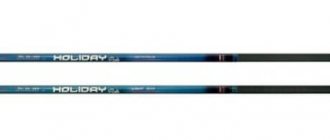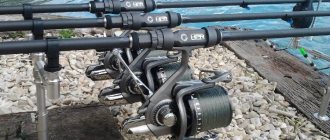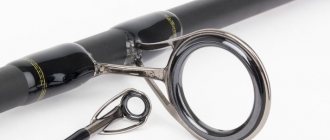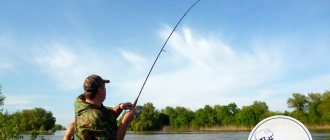Fly fishing has recently become popular among anglers. This is due to the fact that fishing can be carried out throughout the entire period of open water. You can catch a variety of fish: grayling, salmon, rudd, perch, roach. Cases of catching carp, crucian carp and even wary asp are not uncommon.
Design features of the gear
The success of fly fishing largely depends on the correct selection of each element of equipment. Fly fishing gear consists of:
- Rods;
- Coils;
- Cord;
- undergrowth;
- Lures.
When choosing equipment elements, you should not skimp. When preparing equipment, you should not use unnecessary elements; if possible, you should limit the number of nodes. During the fishing process, some auxiliary elements may be required:
- Carbines;
- Additional leashes;
- Connectors;
- Floats.
IMPORTANT! The gear should be easy to use and lightweight, with maximum sensitivity.
Fly fishing rod equipment
The success of fishing with fly rods depends on the correct selection of equipment. It includes:
- cord;
- coil;
- undergrowth;
- bait.
Sometimes rods are equipped with carabiners, connectors, and floats.
For fly fishing models, multiplier and automatic spinning reels with adjustable drag are suitable. They must differ in the following characteristics:
- light weight;
— high strength;
- balance.
The most important and most expensive element of the equipment is the cord. It can be floating or sinking. The first option is more suitable for beginners. Floating lines are easy to cast and effortless to control. When fly fishing, it is necessary to have an additional cord for large trophies and for practicing casts. Such equipment is selected according to the weight of the planned prey, the throwing range, and the type of leash. The cross-section of the undergrowth should be less than the cross-section of the cord. As for lures, dry and wet flies are used in fly fishing. When choosing them, you should focus on the characteristics of the reservoirs, fishing conditions and prey preferences.
Choosing a fly fishing rod
So, it is important to know that for fly fishing today there are various options for fishing rods, differing in classes. As this indicator increases, the resistance of the gear to operational loads increases.
Today, a wide range of fly fishing rods are offered, which will allow you to choose an option taking into account individual wishes and the conditions of upcoming use. Note that rods differ from each other not only in length, but also in class. For a novice fisherman, we can recommend class 6-7 gear - this is enough to catch fish weighing up to 4 kg.
When you go to a fishing store with the desire to buy a fly fishing rod, you will be offered models consisting of 2-4 elbows, it is important to know that:
- Double-knee fishing rods have the advantage of increased strength, which is due to the minimum number of joints;
- Rods with more than two elbows are less reliable. But their main advantage is their length - it allows you to accurately cast light bait over considerable distances.
When choosing a fly fishing rod, special attention should be paid to the material from which the blank is made. Today, manufacturers offer models in the production of which bamboo, carbon fiber, and fiberglass were used. Each option has its own advantages and features. The main thing is that the chosen fishing rod is of sufficient rigidity.
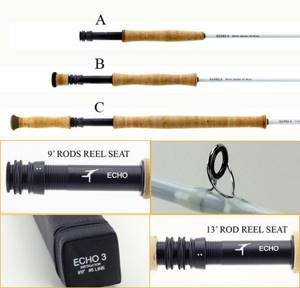
A and B are one-handed rods. C – two-handed. Echo 3 Instructor. Weight – 130 grams. 4 knees.
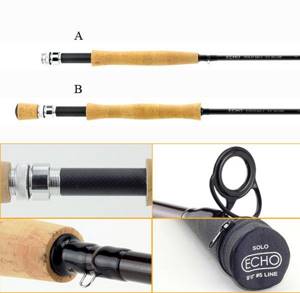
The next point is length . This is an important parameter, since this largely determines how far you can cast. Depending on the class of the fly fishing rod, the length can range from 2.1-3.6 meters . Note that depending on the length, the number of throughput rings from 5 to 11 pieces .
Fishing rods up to the second class are only 2.1 meters and are designed for short casts of light baits. Gear from class 3 to 6 is offered in lengths of 2.1-2.7 meters . Beginner fishermen should choose gear from this category. Rods from the 6th class have a length of 3.4 meters, they allow you to use heavy baits and perform ultra-long casts.
Build
The next important point that distinguishes all models of fly fishing rods is the action. According to the parameters, the forms differ into types:
- Fast build . They are convenient for making accurate and long casts. Such gear is suitable for experienced fishermen who are fluent in all casting techniques;
- Medium-fast action . These fishing rods are designed for fishing with heavy baits; they require fast and hard work;
- Medium build . The rods are universal models; they are suitable for fishing using baits of various weights, regardless of the conditions in which fishing is carried out;
- Slow build . Their use is especially beneficial in calm weather, if fishing at an average distance is required. When casting such gear, the angler is required to have smooth movements.
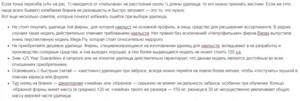
A novice fisherman can be recommended to start mastering fishing using gear whose form has a medium-fast or medium action.
Fly fishing reel
If you are just starting to master this new type of fishing, it is recommended to choose a reel option with an adjustable brake. Note that the main task of the brake is to prevent the free descent of the cord when the caught fish jerks strongly. The main thing is that the weight of the selected reel matches the weight of the fishing rod used for fishing. Today we offer for fly fishing:
- Multiplier;
- Automatic;
- Regular.
Salmo Diamond FLY 5/6. Cheap basic option for beginners. Weight 115 grams, price from 520 rubles. Class 5-6. Karbloplast, brake adjustment.
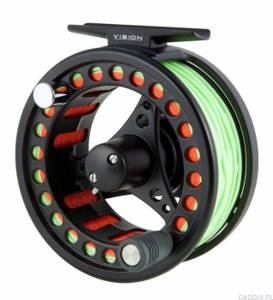
Koma by Vision. A more expensive and reliable option. Variations of classes from 5-6 to 9-11. The capacity of the line laying machine is 61 meters. Weight up to 20lb. The weight of the reel is 177 grams. Price from 5010 rubles.
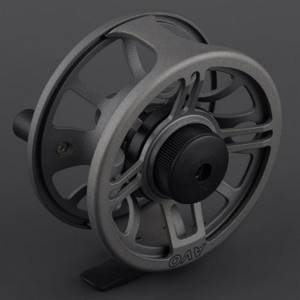
An intermediate option for beginners. Capacity for fishing line up to 40 meters. Price up to 2690 rubles. Regardless of the reel option chosen, it is important to consider that this element bears a large load during fishing. Basic requirements for a fly fishing reel:
- Small size;
- Lightness and strength;
- Simplicity and reliability of design;
- Dynamic balance;
- Corrosion resistance.
When choosing a reel, you should focus on the class of the fishing rod; only if you choose the right one, you can expect that during fishing the convenience and ease of performing all processes will be guaranteed.
Fly line
The most expensive part of fly fishing equipment is the cord, which is due to its relatively rapid wear and tear during active fishing. Today, fishing stores offer sinking and floating line options. Beginner anglers are advised to master the process using a floating line, it is easier to cast and control while fishing.
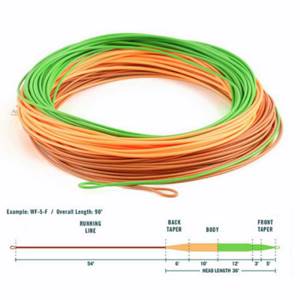
Fly line stretchability
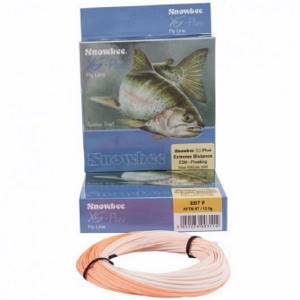
Snowbee XS Plus cord
A prerequisite is the presence of an additional cord (backing) , it is used for catching large fish, as well as for training casts. A novice fisherman should always have two sets: for fishing and for training.
There are different classes of fly fishing cords ; let’s look at their features in detail:
- Cords up to the third class are used to catch small fish, small baits are used.
- Class 4-5 cords are designed for fishing using medium-sized flies, with an average cast of up to 16 meters. They belong to the lungs;
- Class 6-7 cords are designed for casting with a range of up to 20 meters. With their help, you can even continue fishing in windy weather ;
- To catch salmon and other large fish, class 8-9 cords are used; their use allows you to make accurate casts at a distance of 22-25 meters .

ST is used with a long leader. The cord is selected individually in each case, but note that it must correspond to the class of fishing rod on which it is planned to be used. Regarding color design, it is recommended to start with white options, since they are clearly visible in the water in any weather.
In addition, when choosing a cord, it is important to consider that all offered options differ in two types:
- Double-cone (designed for casting a fly over a short distance of up to 12 meters);
- Single-cone (for throwing bait over significant distances from the fishing point).
After fishing, you should use a special product, which may be included in the kit, to clean the surface of the cord from excess moisture - this will somewhat extend its performance.
Criterias of choice
In practice, there are few specialized stores for this equipment and “whips” are found in smaller quantities next to spinning rods, which sales consultants are more focused on.
List of the best manufacturers:
- American company ORVIS, founded in 1856. One of the world leaders in the production of fishing equipment.
- Amundson. Canadian brand, famous among professional and amateur fishermen.
- Vision. Trademark from Finland. Our own technologies are focused on producing high-quality products.
- Sage. Another representative of the USA, annually updating the line of popular designs.
- Russian manufacturer Kola-Salmon. The company was registered in 2003 and specializes in the production of rods and equipment for fly fishing.
A high-quality model will allow you to enjoy the fishing process. Here, as when using a spinning rod, it is necessary to take into account that the appropriate functional equipment is placed on a powerful stick. And vice versa, the smaller the prey, the easier and more elegant the fishing gear should be used. The same principles apply when selecting a fly fishing rod.
Classes
Comparable to the spinning line test. The higher, the heavier the equipment and fittings, which means the heavier the trophies. Initially, manufacturers defined 15 classes, but with the improvement of technology, the introduction of lightweight and durable materials and cords, the indicator expanded. There are currently 21 valid classes from 000 to 18.
Gradation of application:
- 000-3 are used in shallow waters, still waters, small rivers and streams.
- 4-6 are caught in medium-sized reservoirs with a small current.
- 7-9 a large predator can become prey.
- from 10 are focused on catching salmon and marine life.
For beginners, a range of 4-6 is suitable.
Build
For spinning, it shows the response of the blank to the load and its distribution along the length. In fly fishing, the characteristic takes on a different meaning. The faster the action, the more energetic the message for the line that casts the fly. The table of curvatures will clearly show with examples.
Decoding types of formation:
- Extra-Fast - fast (hard). Only the top is involved. A high speed of flight of the cord is ensured even during a gust of wind. Used by experienced fishermen for long-distance casting.
- Fast - medium-fast (upper parabolic). The working part is the upper third of the stick. The rods are stiffer and sharper, capable of working with weighted baits.
- Medium - average (parabolic). When folded, it resembles a parabola. The bend occurs from the tip to the middle. The action is considered universal and works with a wide range of flies.
- Slow - slow (soft). Curve along the entire length, from the tip to the butt. The cord straightens out slowly, which ensures precise delivery of the bait.
As a disadvantage, it can be noted that the effect is achieved in the absence of wind.
A slow pace is suitable for beginners; it provides the opportunity to acquire certain skills and experience. If a beginner is determined to stay in fly fishing for a long time, then it is recommended to take a closer look at medium action poles. This is more expensive, but the “soft” purchased early will not go into storage for a long time.
Length
Depends on the class, features of the fishing spot and who is being hunted:
- The length of 1.8 to 2.1 m indicates that it is a light class 0-2. They are used on small rivers, which is called “catching in front of you.”
- Lengths in the range of 2.2 m-2.4 m correspond to categories 3 and 4. Casting to a distance of up to 10 m is possible. But, as a rule, long casts are not used in fly fishing. The bait must be visible in order to track everything that is happening.
- On medium rivers and wide reservoirs, they take fishing rods from 2.5 m to 3 m. This is 5-6 gradation. The most common length is 2.7 m. It is possible to catch specimens weighing 3-4 kg.
- A 4.5 m rod is used to fish for large salmon, trout, and taimen. Level 7-9 gear.
- For the sea, powerful gear from class 10 is purchased.
Lever
Available in one-handed and two-handed versions.

For beginner anglers, one-handed ones are recommended. This type of equipment is easier to control and makes casting easier. On popular and expensive models, the handles are made only of cork. Lightweight and practical material, fits well in the hand and does not slip. There are cigar-shaped and classic (English) shapes. In addition, the cork is practical to repair and adjust to the palm using simple abrasive tools.
Passing rings
They have distinctive features. Larger in size than on a spinning rod. Silicon inserts are not used, because a thick cord does not slide well. Popular fittings are made of chrome-plated steel with aluminum oxide inserts.
According to the mounting option, they are distinguished:
- Single-legged (half-snake):
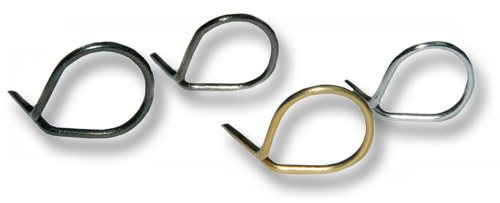
- Two-legged (snake):
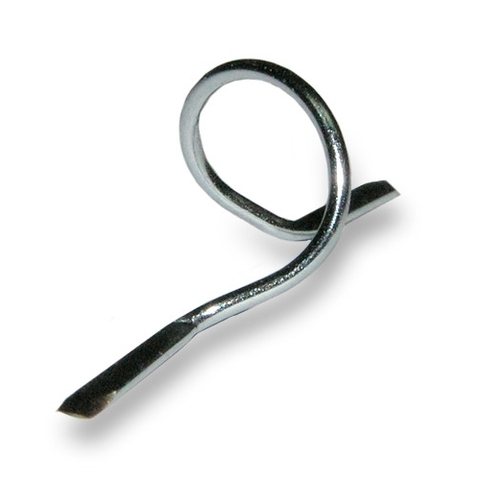
Material of manufacture
Modern technologies are capable of producing equipment weighing from 80-300 g.
- Fiberglass. Low quality, quite heavy, so it is gradually being replaced.
- Carbon fiber. Popular due to its lightness, which is important in fly fishing.
- Glued bamboo. Expensive material, because models are made by hand. There is no better fishing gear for short distances. Soft and sensitive fishing. As a disadvantage, low moisture resistance is noted.
- Tree. The first specimens from the early days of fly fishing. Currently not produced, rare examples can be seen in private collections.
Joints
The following joint options are available:
- Plug-in. A plug is built into the lower half, onto which the upper elbow is placed. A feature of such a connection may be the preservation of the gap between the parts. This is a factory norm, and not a defect, as many people think.
- With a soft form, the lower part is inserted into the upper.
- On the contrary, with a hard and sharp system, the upper section is put on the lower one.
For any type of connection, it is necessary to assemble the rod and check the tightness of the fit at the joints.
The main indicators are plotted on the form. Marking features: weight is indicated in ounces, length in feet.
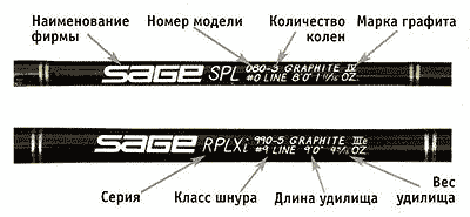
Which fishing rod is better, which brand is a worrying question for many, how and at what price, should you buy a top model right away or take a closer look at a budget model?
Leash and leader for fly fishing tackle
The undergrowth is always selected with a decrease in relation to the cross-section of the main cord. The reduction can start from 0.5 mm, ending with 0.2 mm. The thick side of the leader is attached to the cord, and the thin side is the fly.
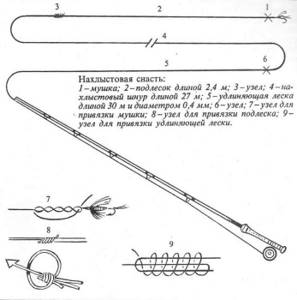
How to tie a fly to a leader
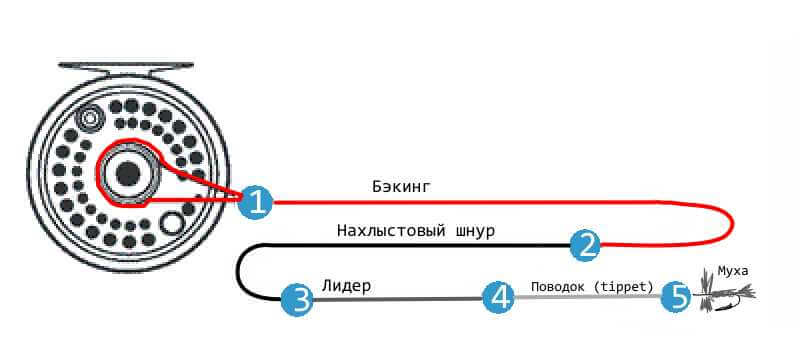
Gear device
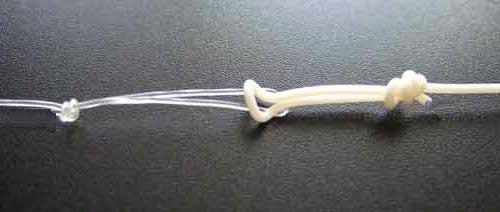
Fly fishing connection between leader and main line
Note that when planning a fishing trip you should always have with you a sufficient set of undergrowth relative to the length. So, for example, when fishing in windy weather, it is preferable to use short undergrowth.
After a series of casts, it is necessary to check the condition of the cord for the formation of knots. Their presence is not desirable, since it reduces the tensile strength. Therefore, if a knot appears on the undergrowth, it is recommended to immediately replace it with a new one.
Fishing technique
The most important point in fly fishing is casting the line with the fly. This technique requires persistence and time. Repeated training will give positive results in the end.
When casting from a reel, part of the cord unwinds, which must be held with your left hand. With your right hand, move the rod back behind your head and then forward. Movements forward and backward should be smooth and slowly increase. When the maximum is reached you need to cast the fly.
A fly that has fallen into the water imitates a living animal. An important aspect at this stage is that the leash matches the speed of the water flow. If not, then the fish may become wary and there will be no bite.
The best option for a beginner is to go bleak fishing . This fish bites on any bait. Another advantage of catching bleak is that you don’t have to cast a fly fishing rod far, because this fish is not a shy fish. The bleak bites well, with passion.
The second important stage of fly fishing is retrieving the bait. It must be remembered that the angler’s actions will vary depending on the bait (fly) and the area where fishing takes place (presence of current). Despite this, the cord must be well tensioned under all circumstances. This is to hook the fish when it bites.
The third important point is landing the catch (fish). When fly fishing, there is no need to rush, you need to tire the fish first, and also make sure that the line does not become loose or tangled. Be sure to have bait with you if you have information about catching possible giants.
Options for fly fishing
So, your fishing suitcase should contain a sufficient set of baits. Today we offer a variety of wet and dry flies. They are designed for fishing in certain conditions and specific fish.
It is more convenient to start mastering the process using large sizes, namely 6 , 4.5 , 3.5 . You can gradually switch to smaller flies, but note that the smaller the bait used, the more sensitive the tackle as a whole should be.
For a novice fisherman, we can recommend the following two options, which are distinguished by their versatility:
- Dry Wickham's Fancy (golden hue);
- Wet March brown .
- Kola Salmon Fly Fishing Tackle.
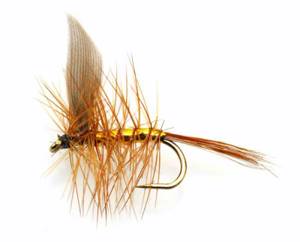
Wickham's Fancy
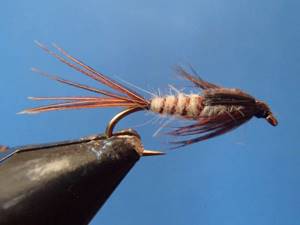
March Brown
With their help, you can not only learn how to make accurate casts, but also count on catching several trophies.
After fishing, all flies that were involved in the fishing process must be thoroughly dried. If the bait has lost its original appearance, for example, the feathers have stuck together, then you can restore the attractiveness of the fly by holding it over steam.
Fly tying, video
What kind of fish is caught fly fishing using flies?
So, flies are highly effective baits that are great for catching various fish that are found in rivers. The most common fish you can catch with flies are:
- Grayling . Wet and dry versions of fish are used. Both options can be used simultaneously. In this case, the dry fly is a bite alarm. Fish are more likely to attack a wet fly. Soft flies with a red or yellow belly work best for grayling. For fishing in muddy water, the choice should be made of orange or pink shades;
- Asp . The best solution for catching this predator is wabiki. The design of such a bait can simultaneously contain 2-3 hooks, which are camouflaged with fur or white feathers. In addition, streamers and wet flies are used. Asp are more attracted to baits with yellow, blue, white or pink light design or a successful combination of these colors;
- Rudd . Streamers of yellow, white and gray shades are mainly used. During the fishing process, two baits can be used simultaneously;
- Chub . Fishing is mainly done with various types of wet flies. If the fish is well active, the color of the bait does not matter; in all other cases, while fishing, you need to constantly experiment not only with the size of the fly, but also with the color;
- Yelets . You can catch this wary fish using a large, dark-colored dry fly;
- Perch . To catch perch, prepare a rig with several nymphs or wet flies. It is recommended to choose baits in white, red or black shades.
- Trout . Hooks available in 6 sizes. Dry flies of faded shades.
When choosing flies for fishing, you need to take into account the type of insects that are currently located in the vicinity of the water area. Based on this, variants of flies are purchased or made independently, which in appearance should be similar to the insects that the fish feed on.
Characteristics of rods
By material
- Made from fiberglass. Gradually falling out of use. This is due to its heaviness, unnecessary vibrations when casting and not very high quality. Such rods are inexpensive, and there are companies that still produce them for fishing at a short distance from the shore.
- Made from carbon fiber. The most common material for fishing rods today. Its main advantage is its lightness, because when fly fishing, the main physical load falls on the hands. Such gear is more expensive than their fiberglass counterparts, and this is the case when the quality justifies the price: the higher it is, the better the rod corrects mistakes made when casting.
- Made from laminated bamboo. These fishing rods are made by hand, so they are the most expensive in this segment. They require special care: moisture ingress makes them vulnerable.
- Made of wood. Today this natural material is no longer used for the production of fishing rods; they can only be purchased from collectors. Such fishing equipment has great power and significant weight.
By class
There are 21 of them in total: the division depends on the weight of the cord, which can change at the moment of throwing. Only the first nine meters of cord are counted. The lightest class is 000, the heaviest is 18. The higher the class, the heavier the bait you can use and count on catching heavier fish. If you plan to catch small fish in good weather, rods of 0-3 classes are suitable. To catch medium-sized specimens in lakes or on currents, it is better to use gear belonging to classes 4-6. Predatory fish should be caught using equipment of 7-9 classes. Rods from class 10 and above are intended for sea “hunting” for large fish.
By weight
This parameter is directly related to the class of the rod: the lower it is, the lighter the tackle will be.
By formation
The indicator is of fundamental importance: it indicates the ability of the rod to impart a certain amount of energy to the cord. The faster the action, the greater the speed the line can develop when casting.
- Fast (hard). Only the tip bends. This equipment is suitable for long-distance casting. High line speed is guaranteed, but this requires an experienced hand. Optimal for fishing with heavy bait.
- Medium-fast (upper parabolic). The upper third of the equipment bends. It is possible to use it at medium and long distances using weighted baits.
- Medium (parabolic). The most versatile system, very popular among anglers. The bend of the equipment resembles a parabola.
- Slow (soft). Such equipment bends almost completely along its entire length.
The figure shows a table of rod curvature options. Its decoding shows how part of the rod bends with each specific action.
By lenght
In the classic version, this figure varies from 2.4 to 2.7 m. You can find shorter or longer gear on sale. For example, a rod shorter than 2.4 m is used when fishing from a boat.
By connection type
There are three of them:
- using a carbon fiber pin glued into the lower elbow;
- the upper knee enters the lower one;
- the lower knee is placed in the upper one.
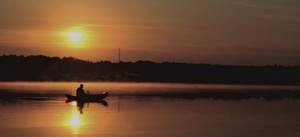
According to the shape of the handle
- full profile (there are extensions at both ends);
- semi-profile (they have an extension only at one end);
- cigar-shaped.
Video tips for choosing a fishing rod:
Fly fishing: features and technique
The fishing process should begin by searching for a promising place. Of course, it all depends on the object being fished, since each fish has its own favorite places. The next important point is the choice of bait. Baits for fishing are selected based on the fish that you plan to catch, as well as seasonal and weather conditions. The technique of fishing with flies is divided into the following components:
- Casting . The fly is cast with the help of tackle several meters further from the promising location. The fly is guided evenly towards itself or drifting downstream;
- Giving the bait a game . While retrieving, you can pull, hold, or sink the cord, or lower or raise the rod. All this will give the fly an additional game that attracts the object of fishing;
- Hooking and landing . When you feel a blow or a hook, which is how a bite is most often expressed, an immediate hook should follow. During the fishing process, you should try to circle possible areas of the snag (thick grass, snags and other obstacles).
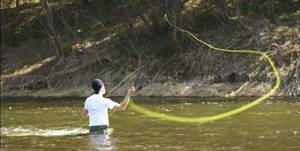
Fly fishing has many advantages over other fishing methods. Provided that the tackle is properly prepared and the bait is selected taking into account all the requirements, you can always count on a good catch in the summer or spring, even with low fish activity.
Principle of execution and casting methods
Having dealt with the issues of preparing tackle for fly fishing, having decided on baits, you can begin the most interesting part, namely mastering the casting technique. Fly casting is divided into the following types :
- Classic or basic – vertical, horizontal, circular;
- Complicated - wavy, crimped, pulled out by a cord, obliquely in relation to the river bed;
- Special - provides for a change in direction, used relative to the wind with lifting, bending, double pulling, twisting undergrowth.
to begin mastering the casting technique by carefully studying the following important points, which can be used in practice in the future. The basic principles are formulated as follows:
- With your right hand you hold the rod by the handle, with the palm of your left hand we press the cord a little higher from the bait;
- Having grasped the tackle comfortably and securely, we perform several strokes, the cord must be in the air the entire time when performing them;
- Additional acceleration is given to the cord by pulling the cord, while swinging forward or in the opposite direction. This will give the cord high kinetic energy and reduce the flight loop even with a small amplitude, making it possible to cast a light bait at a distance of up to 30 meters.
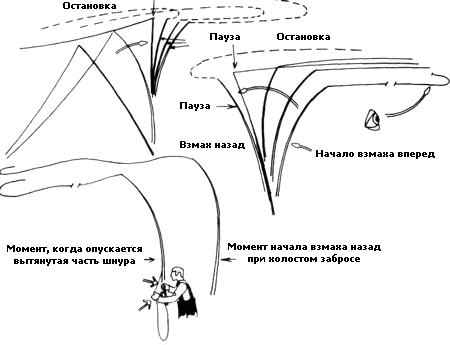
Fly casting promotion

Image #2
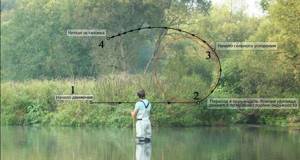
Let us note that many training manuals recommend starting to practice fishing techniques on the lawn, however, according to professional fishermen, it is more correct to start learning on a reservoir, in a real environment.
Fishing tips for beginner anglers
- If a dry fly is used for fishing , then it is recommended to cover it with flotation or fat before the start of the main part of the process, in this case it will be able to remain dry longer;
- Be sure to use a landing net , with which you can conveniently take the caught fish. Its length should not exceed a meter, it is attached to the waist belt on the left side;
- If during prolonged use of a dry fly it gets wet, using a kitchen sponge the bait can be quickly dried by simply pressing it against it, as a result, the moisture will come out of the fly and be absorbed into the sponge;
- During fishing, the line may begin to slide poorly, which negatively affects the casting distance. In this case, it needs to be cleaned using a special liquid, which is offered in fishing stores;
- The stock should have a large number of different options for flies regarding type, size and color design. This will increase the chances of catching the desired trophy.
In conclusion, we note that fly fishing is a promising activity, of course, provided that all preparatory measures are carried out responsibly. Of course, such fishing requires certain knowledge and skills, but if you master them, then when you go to a reservoir, you can always count on a good catch, regardless of weather conditions or fish activity.

